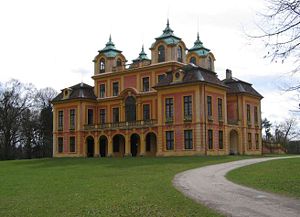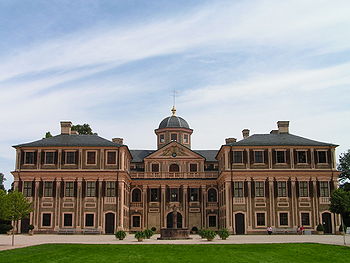- Lustschloss
-
A Lustschloss (French: maison de plaisance, English: pleasure palace) is a small palace which served the private pleasure of its owner, usually the ruler of the area. It is located in, and was inhabited for court, ceremonial, and state duties.
A Lustschloss is often coupled with a Jagdschloss. Both served as non-formal residences, but a Jagdschloss was a hunting retreat and was mostly used to accompany a hunting party.
History
At the beginning of the Renaissance, the wish for non-militaristic castles appeared in the nobility and they slowly left their old fortified castles, or altered them into homely residences. In the course of a few years, many of the noble families' seats grew up into big estates; at the same time the court ceremonial changed. Now the prince stood more and more in the center of a luxurious royal household that reached its zenith during absolutism. The nobility then surrounded themselves with artists, fawning courtiers, envoys, servants and petitioners. Often the residences overflowed with guests.
The wish for more intimacy led to the construction of the Lustschloss, to which often only certain circles of acquaintances had access. Here its owners could withdraw with their family and their relatives. At the Lustschloss one could devote himself to leisure or pleasure. The Lustschloss was above all, a place for parties, dancing and music. It often also was used for literature and painting. With it they formed the contrast to the real residence, which was often nearby. It served the state, in which etiquette had to be protected.
The most popular architectural styles of these particular castles were baroque and rococo which both displayed a sense of wealth. The Lustschloss was often located in a splendid schlosspark, mostly distinguished by especially extensive and valuable decorations. At the same time the rooms and drawing rooms became more intimate and more comfortable. Significant artists from their respective region would worked on many of their paintings in the castle. Famous examples are the Grand Trianon and the Petite Trianon in the gardens of Versailles, and at the Castle Marly-le-Roi or the Amalienburg in the schlosspark of Nymphenburg.
The name Lustschloss was often used interchangeably with the word Schloss, which is an unspecialized residential castle. The purpose of a Lustschloss also changed – it could be developed in the course of a few years and was remade into a castle which took over representative tasks. An example of this is Sanssouci, which was originally established as a summer house, and for a period of time, it delevoped into the main residence of Friedrich the Great of Prussia.
Some famous German Lustschlosses are Schloss Benrath in Düsseldorf and Schloss Favorite in Ludwigsburg. The Lustschloss Favorite in Mainz had been destroyed during the siege of Mainz (1793).
See also
Categories:- Castles by type
Wikimedia Foundation. 2010.


